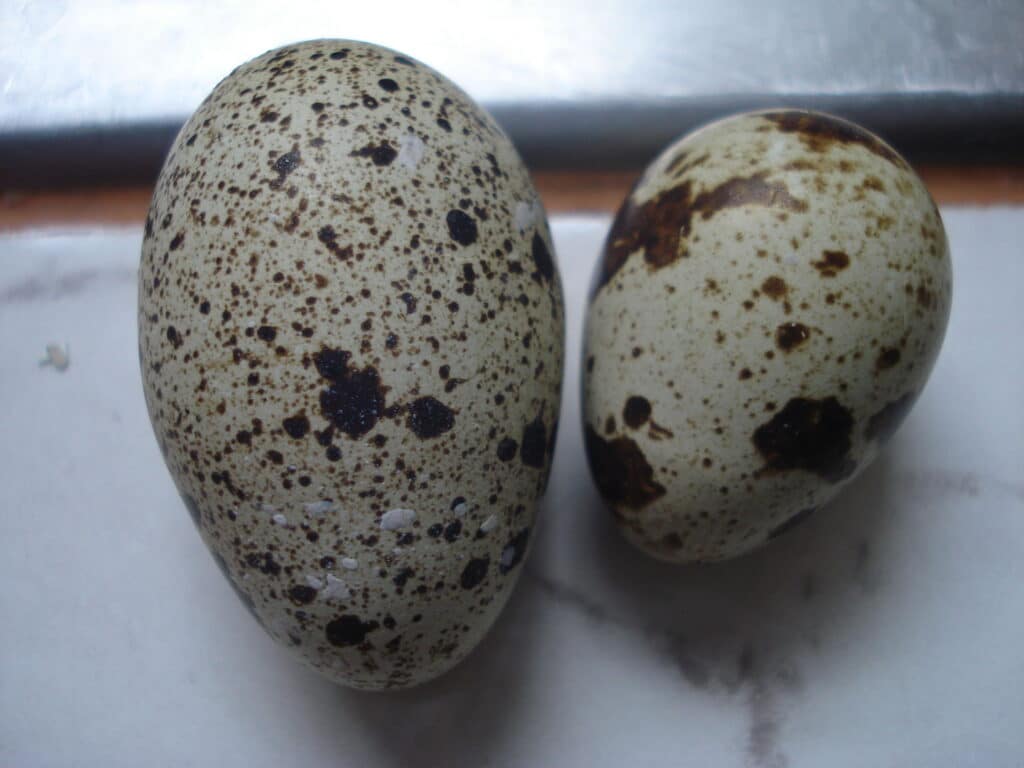Quail Eggs
What are they?, history, cultivation, nutritional value, uses, recipes, and more...
Quail eggs are the eggs laid by the common quail (Coturnix coturnix), a species of galliform bird in the Phasianidae family that is widely distributed across Eurasia and Africa. These eggs are known for being smaller than chicken eggs and more nutritious. They stand out for their high protein content and almost negligible carbohydrate content.
Índice
What are Quail Eggs?
Quail eggs weigh anywhere from 2 to 15 grams, with an average of 10 grams. The weight is correlated with both the thickness of the shell and the egg’s overall strength.
The longitudinal dimensions of these eggs have a diameter of 3.14 with a typical deviation of 0.12, and the transverse diameter is 2.41 with a deviation of 0.24.
In most cases, they have an oval shape, although there is a 20% probability of them being round or tubular in shape. There have even been observed instances of elongated quail eggs, usually caused by a deficiency in some parts of the bird’s genital organ.
Quail eggs are white with brown or black spots and are known for their excellent nutritional properties. They contain unsaturated fatty acids, a digestibility level of 96-97% with high concentrations of vitamins B1 and B2, as well as significant amounts of essential vitamins such as E, A, D, and C, vital for child development and combating rickets.
History of Quail Eggs
The quail originates from Asia, particularly China, from where it was later transported to Japan. It is believed to have reached Europe in the 12th century and then spread to the rest of the world.
There are ancient documents, such as the Bible, where the capture of quails in the desert is mentioned, indicating them as the sustenance provided by God as rain from the sky to the people of Israel (Exodus 16:13, Numbers 11:31, Psalm 105:40).
“That evening quail came and covered the camp, and in the morning there was a layer of dew around the camp.” (Exodus 16:13a)
The ancient Egyptians also recognized the nutritional benefits of quails and established large farms to raise them. These birds were so common in the country that they had their own hieroglyph. In Egyptian, the word for quail is pronounced “Oo.”
It’s estimated that quails were domesticated more than 4,000 years ago, and during the 11th century, they were domesticated as pets in China. They were later introduced to Japan a century later, mainly to delight with their presence and the male’s song in the imperial court.
Between 1910 and 1940, there was an imperial expansion of Japan, allowing quails to establish themselves in Korea, China, Hong Kong, and throughout Southeast Asia. This species then spread to Europe and the United States, from where it disseminated to nearly all countries worldwide.
While quails were initially domesticated in Japan for their song, this changed when an emperor reported curing tuberculosis thanks to a diet based on quail meat. This news led to the massive production of quail meat and eggs in the late 19th century.
The Coturnix Coturnix Japonica was brought to the United States in the 19th century as a research and decorative bird and has subsequently gained importance in the poultry industry.
In most countries in Latin America, the breeding of this species began with imports from the United States in the mid-20th century, with Brazil and Argentina being among the earliest countries to raise quails.

Common Name of Quail Eggs
| Spanish | codorniz común, codorniz japonesa, codorniz oriental, codorniz asiática, codorniz faraona, codorniz pecho rojo, codorniz real y codorniz real japonesa. |
Scientific Name of Quail Eggs
Coturnix coturnix
Taxonomy of Quail Eggs
| Kingdom | Animalia |
| Filo | Chordata |
| Class | Aves |
| Order | Galliformes |
| Family | Phasianidae |
| Gender | Coturnix |
| Specie | C. coturnix |
Etymology of Quail Eggs
The word “quail” comes from the Latin “coturnix,” which in turn seems to derive from “cocturnix” and possess an onomatopoeic root *quok, imitating the sound made by hens.
Habitat of Quail Eggs
- Habitat
Habitat of Quail Eggs
The quail is a polygamous species. The male is capable of mating with multiple females consecutively, and these females, in turn, can be fertilized by more than one male within a few hours. Mating usually takes place upon the quails' arrival at their nesting grounds.
Nesting occurs from mid-May to late July but can extend until August and September. The eggs are laid in a slight hollow lined with dry grass and situated in a field of wheat or other cereals.
The incubation of quail eggs lasts approximately seventeen days and is exclusively carried out by the female. Upon hatching, the chicks typically follow the mother and peck. At fifteen days, they can flutter, and by a month, they can fly like adults.
Quails lay one egg daily, usually collected in the morning, and it's recommended that they receive 15 hours of light per day to enhance their production.
Raising quails can be a profitable venture due to the minimal capital required and quick returns. These birds are quite economical, easy to care for, and do not require large areas of land.
Varieties of Quail Eggs
Although more subspecies have been described, currently, five are recognized:
-
C. c. coturnix (Linneo, 1758)
-
C. c. conturbans Hartert, 1917
-
C. c. inopinata Hartert, 1917
-
C. c. africana Temminck y Schlegel, 1849
-
C. c. erlangeri Zedlitz, 1912
Nutritional Value of Quail Eggs
They have a very similar percentage of calories to chicken eggs. Each 100 grams of chicken eggs contain 150 kilocalories, while quail eggs contain 154 kilocalories. However, remember they are smaller: an average chicken egg weighs 65 grams, and a quail egg weighs about 10 grams. So, several quail eggs would need to be consumed to match the energy contribution of one chicken egg.
Quail eggs have a slightly higher percentage of proteins compared to chicken eggs. In the former, we find 13.1g per 100 grams, while in the latter, there are 12.5g. Therefore, quail eggs are an excellent ally for increasing muscle mass. Both types of eggs have similar fat percentages (11.1 grams), but quail eggs have twice the cholesterol of chicken eggs (844mg vs 385g).
An added value of quail eggs is the percentage of iron they can provide. They have nearly double the iron of a chicken egg. In 100 grams of a quail egg, there is 3.65 mg of iron, while in chicken eggs, there is 1.9mg. Quail eggs help prevent anemia.
Likewise, they have a good percentage of folates, a key substance for tissue formation during pregnancy and essential for proper closure of the fetal neural tube. Quail eggs have 66mcg of folates, while chicken eggs have 50mcg.
The eggs of these birds are rich in vitamin A: we find 156 mg of this vitamin. Due to its vitamin A levels, quail eggs help maintain good vision and promote growth in children.
Quail eggs contribute 1.4 mcg of vitamin D. Therefore, they allow for the proper functioning of the immune system, strengthen bones and teeth, and facilitate the absorption of phosphorus and calcium. They are also rich in vitamin B12, which contributes to red blood cell formation.
Health Benefits of Quail Eggs
Quail eggs are rich in vitamins and minerals. Additionally, they are highly recommended for diets of atherosclerotic and hypertensive individuals due to their low cholesterol content.
Contraindications or Side Effects
There are no known side effects or allergies related to the consumption of quail eggs. However, individuals with poor digestibility of protein, liver disorders, or kidney disorders should consume them with caution.
Similarly, it is not recommended to consume more than 6 per day, as it could increase cholesterol in the blood, promoting potential cardiovascular diseases.
De la misma manera, no se recomienda consumir más de 6 al día porque puede aumentar el colesterol en la sangre, promoviendo posibles enfermedades cardiovasculares.
| 10 Porciones por Kilogramo | |
| Tamaño de porción | 100g |
| Cantidad por porción Calorías |
434 |
| Cantidad por 100g | |
| Energía | 1,814 kJ |
| Grasa Total | 12.7 g |
| Sodio | ● |
| Carbohidratos totales | 74.9 g |
| Carbohidratos disponibles | 73.8 g |
| Fibra Dietaria | 1.1 g |
| Proteínas | 6.0 g |
| Calcio | 22 mg |
| Fósforo | 665 mg |
| Zinc | 0.64 mg |
| Hierro | 0.60 mg |
| Potasio | ● |
| Agua | 4.8 g |
| Cenizas | 1.6 g |
| Vitamina A | 0 μg |
| Tiamina (B1) | 0.04 mg |
| Riboflavina (B2) | 0.04 mg |
| Niacina (B3) | 0.50 mg |
| Vitamina C | 0.00 mg |
| Acido Fólico (B9) | ● |
| β-Caroteno | ● |
| Fuente: Tablas peruanas de composición de alimentos – Centro Nacional de Alimentación y Nutrición – Ministerio de Salud – Perú | |
Derived Products and Consumption Methods of Quail Eggs
Uses of Quail Eggs
Quail eggs can be used in cooking just like chicken eggs and provide even more nutrients than them.
- Culinary
- Medicinal
Culinary Use of Quail Eggs
Due to their content of vitamin D, quail eggs strengthen the immune system. Additionally, they prevent respiratory diseases. Some studies suggest they can be excellent allies in fighting allergies.
They help maintain proper lung function and even aid in treating diseases like tuberculosis and asthma. Being rich in antioxidants and fatty acids, they act as natural anti-inflammatories.
They assist in preventing anemia and even increasing hemoglobin levels in the body. They have a positive effect on glucose and can be beneficial in the diet of diabetic patients. They also contribute to lowering blood pressure due to their high potassium content. Quail eggs improve metabolism due to their content of various B-complex vitamins.
Medicinal Use of Quail Eggs
Quail eggs are believed to have medicinal properties that include:
Immunity Enhancement: It has been suggested that quail eggs can strengthen the immune system and help prevent diseases.
Respiratory Disease Treatment: Some studies have indicated that quail eggs may be useful in treating respiratory conditions such as tuberculosis and asthma.
Anti-Inflammatory Properties: The antioxidants and fatty acids present in quail eggs are believed to act as natural anti-inflammatories in the body.
Anemia Prevention: Quail eggs are rich in iron and can help prevent anemia by improving hemoglobin levels in the body.
Metabolism Improvement: Due to their content of B vitamins, quail eggs are claimed to improve metabolism and provide energy to the body.
Eye Health Support: Because of their vitamin A content, quail eggs are thought to maintain good vision and promote growth in children.
Bone Health Support: Quail eggs contain vitamin D and calcium, which are essential for bone and dental health.
Blood Pressure Reduction: Due to their potassium content, quail eggs are suggested to help lower blood pressure.
It's important to note that while quail eggs may have potential health benefits, scientific evidence in many of these cases is limited. Consult a healthcare professional before making significant changes to your diet or starting to use quail eggs for medicinal purposes.



